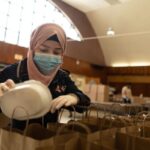Over the last 40 years, the U.S. has admitted between 22,000 and 230,000 refugees annually. While refugees and immigrants arrive with rich cultural food traditions, many of which are health-promoting, they can erode over time, resulting in diet-related disease rates similar to those of U.S.-born populations. Structural inequalities, transit limitations, and a lack of affordable, culturally appropriate produce in their new communities (often designated “food deserts”) can all negatively contribute to this population’s food access and dietary intake. This blog post shares findings that can help inform your own food security work with newcomer clients.
While access to food is a basic human right, many new Americans don’t have access to healthy, nutritious, and culturally appropriate food all year round. New Roots is a program of the International Rescue Committee (IRC) that supports food security among new Americans through culturally appropriate nutrition education, as well as urban gardens, farms, and markets across the United States. New Roots recently set up a useful survey tool for measuring food security among newcomer clients and used that tool to collect data on its programs across a myriad of interventions. What follows are the findings from that survey, along with possible action points to address the issues. An explanation about the evidence-based survey methodology that was used to collect this data is available at the conclusion of this blog.
Six Key Findings and Action Points from the New Roots Food Security Surveys
- Food insecure clients often require additional services, particularly those that improve their economic well-being. Service providers interested in assessing food security should have a developed food security support plan for clients that includes income and employment support options, as well as emergency food assistance.
- Food security fluctuates for many clients. If someone has just enough money to meet basic needs, that doesn’t mean they are always food secure. These findings support other previously published evaluations on how extended support for newly arrived populations results in better long-term outcomes. As many of us know, the initial Reception and Placement (R&P) 90 days of support is critical, but more support may be needed for some clients. To address this issue, in addition to job-related support, programs can provide information on where to find free food resources, how to navigate supermarket deals more efficiently, and how to create a basic household budget, including meal planning. Additional money-saving and meal-extension strategies—such as freezing, drying, and pickling food to help extend the use of produce—can be introduced as appropriate. For clients involved in food production, providers can offer training on using a greenhouse in the winter and preventing sun scalding in the summer heat.
- Key barriers to food access include lack of transportation and the high prices of culturally appropriate produce. Various national programs exist to support clients who are eligible for the Supplemental Nutrition Assistance Program (SNAP) and the Special Supplemental Nutrition Program for Women, Infants, and Children (WIC) by matching and sometimes doubling the benefit amount for healthy food. One such program is called Double Up. Cities like New York also have Health Bucks programs. For issues with transportation, partnerships with food delivery services can be explored. For example, Instacart recently published a study where they found that SNAP-eligible users saved money and time by using their platform for deliveries. There are also many local food delivery options such as community supported agriculture (CSAs), which can be a great way to support the local food system and deliver healthy produce to people in need.
- Gardening activities that help build social connection can potentially have more impact than gardening without the framework of social interaction. Some survey respondents noted that even if they garden for food, they were still not food secure because gardening on its own does not produce enough consistent and varied supply. The gardeners who scored food insecure also had lower rates of sharing or receiving food from others, which suggests that they had fewer social connections. In most cultures, sharing food plays a big role in social connection. Resettlement agencies and sponsors can help build social connections by supporting activities that help connect participants to each other and to other services, especially for those who are more vulnerable according to the surveys.
- Risk of food insecurity is high for newly resettled clients and requires a holistic response. Ongoing barriers to reliable food access—such as food and housing cost inflation and delays in receiving Social Security numbers, work authorization, and SNAP benefits—call for systematic food security planning among donors, implementing agencies, and policymakers with improved linkages and coordination. This includes building capacity for resettlement agencies to be able to provide support with comprehensive household budgeting and financial coaching to plan for the future and to anticipate strategies to support family food security in the face of economic uncertainty.
- Client food security should remain a key priority for refugee– and immigrant–serving agencies. Newcomer families have an unabated need for access to culturally relevant food. Many live in food deserts and face food price inflation. Resettlement agencies and partners play a key role and require more support to be able to answer the diverse needs of the populations and communities they serve. While the report data pre-dates the end of the Pandemic Health Emergency SNAP supplements, we can already see how those who have unstable food security will be adversely impacted by this change.
A Note on Selecting the Most Appropriate Tool to Measure Food Security
Measuring food security among newcomers is critical to understanding both ongoing needs and the impact of interventions, but it can be challenging to know what tools to use. In 2020, after reviewing several types of evidence-based food access and food security measurement tools, New Roots adapted an evidence-based survey called the Household Food Insecurity Access Scale (HFIAS). The HFIAS was created by Tufts University and Cornell University, along with other partners. It has since been adapted for use across many cultures and contexts abroad, as well as Canadian Inuit populations and homeless populations.
The HFIAS tool is inclusive of many cultures and uses terms and concepts that easily translate into many languages. It captures several dimensions of food insecurity in a way that focuses on the person’s experience from their perspective and key barriers to food access, which are not always economic. For example, the tool avoids terms that are hard to translate, such as “balanced meal.” It also recognizes that, while economic barriers to food are critical, there are other factors that impact a person’s food access, like a lack of culturally appropriate or preferred food options.
The New Roots team made several modifications to the tool: They prioritized informative questions over intrusive ones and focused on 1) the individual’s anxiety around acquiring enough food, 2) the quantity of food they have access to, and 3) access to their preferred foods. The adapted tool was shortened to three questions for resettlement services and six questions for New Roots programs, due to considerations of staff time and client survey exhaustion. After adaptation, the tools were culturally validated.
The New Roots version of the survey has added questions to collect more information on the link between gardening, social capital, and food access, which do not contribute to the person’s food security score but do provide some insight on the interconnectedness between food production and social capital. It is important to note that the HFIAS survey process is always paired with in-kind food support to IRC clients or active referrals for free food resources. It would be unethical to conduct food access surveys with vulnerable populations without providing adequate support to respond to the findings.
The modified HFIAS was first administered within the New Roots program network and then more broadly across the IRC’s U.S. resettlement programs, inclusive of Afghan Placement and Assistance (APA). Since 2020, the HFIAS survey has been given to over 2,000 clients representing 19 nationalities.
We hope this blog sheds light on what types of barriers exist for newcomers to access culturally appropriate food and how measurement can help support your organizational approaches to bolstering food security from the ground up.
Eugenia will be co-presenting in this year’s International Society for Nutrition Behavior Conference in Washington, D.C., on two panels: 1) Culturally Responsive Practices in Food and Nutrition Security Interventions for New Americans in the United States: Grassroots and Public Health Perspectives; and 2) Inspiring Food Citizens Through USDA-NIFA’s Community Food Projects Competitive Grant Program: A Program that Links the Whole Food System to Improve Food Access, Affordability and Reduce Food Insecurity for American Households. You can view the full agenda here.










